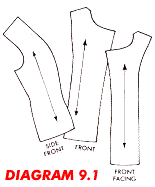
REVIEW
Allison Carter, A Fixed, Formal Arrangement,
Les Figues Press, 2008.
Reviewed by Scott Butterfield
ELEGANT INCOHERENCE
At structurally similar moments in the two sections "In Your Spare Time" and "Garages" of Allison Carter's new book of stories, A Fixed, Formal Arrangement, one is introduced to the book's consciousness and is made aware that this consciousness dictates the terms of its own understanding. In other words, the book tells one how to read it. Consider this example out of "Garages" called "Garage Apartment #21," where the narrator (who is not the same narrator as the previous story, or the next) is in the midst of suffocating on car exhaust in a closed garage:
...and I'm not worried about putting into action another sequence that doesn't end in darkness. I'm not worried about instigating another history that doesn't end with all the peace of being a thing without history.
Although this insinuating passage appears just as the book is about to conclude, it harkens back to the first section, "In Your Spare Time," which is rife with fragments that seem to exist in a vacuum of time and space, fragments in which the reader can't tease out a before, or an after. Consider "My Hand Has Been Amputated:"
When the phone rings I am stroking my fingers, showing them off, what do you do when in the glass you see it, Finally, the cylindrical voids tapping along, the accident, what happens to all the dates you had gotten, do you rephrase, do you stuff the space with superelectric chewable tissue,
Action happens, yes, but what these actions arise out of and what they lead to is never explained. The deeper one reads one understands that these questions are not the point. The vacuous divisions of the book's first half are belied by Carter's use of the comma, absorbing as it does the function of semi-colons, colons, exclamation and question marks, even periods. Each piece ends with a comma, implying continuity in the face of severe fragmentation. Carter's book flits back and forth between narrative point of view and proximity—now in first person, now in close third, now omniscient addressing a spectral ‘you'—with all the healthy abandon of a child openly flaunting parental rules. The pieces do not aim for the traditional coherence that is assumed of prose writers (there is no overt "plot" here), but instead zeroes in on a specific emotion and attempts to rouse its unique shape from slumber. "Bed Time," for example, borders on nausea. "Unracking At Night" conjures up frustrations as small as the shifting of a body in bed. The banal happiness apparent in "One of the Good Days" is balanced by the foreboding sense of doom in "Weather Alarm." A sense of spiritual dislocation permeates the short "Schedule." Nearly all of "In Your Spare Time" takes place in the bedroom, and here characters dream, have sex, talk on the phone, engage in affairs, experience insomnia. This bedroom action contrasts with the exterior spaces in the second section "Garages."
In "Garages," periods and commas have returned to their original uses, but narrative proximity and point of view still shape-shift from piece to piece. "Public Garage 2" is a rather journalistic presentation of sex in a tight space (the front seat of a car) from a female point of view, while "Garage Apartment #6" describes the inability of a male narrator to capture "a picture...of the space between us, not of the figure she cut against the wall." This is Carter's desire as well, the desire to capture a picture of the etheric, emotional space that comingles with physical reality. Characters in "Garages" attempt to communicate that which is not readily understood (emotional instability, desire, fear, spiritual crisis). Carter, to her credit, implicitly acknowledges that person to person communication about certain emotional quandaries is all but impossible, at least, if true understanding is the aim. She has occupied herself with this question: how does one determine the specific weight of emotions, and, once determined, how does one transfer this weight onto another, onto the printed page? "Calcification" from the section "Spare Time" is one of the other moments where the book's consciousness talks to its reader, and it gives a few hints as to how Carter's question can be answered:
Aiming for lovely but getting stuck, crystallizing, but not lovely, it's not like 3 isn't prime, it's not like there's much of a difference between 2 and 3, between lovely and a jammed, wedged, trapped, fixed, formal arrangement,
The crystallization she speaks of is rarely achieved in terms of narrative in A Fixed, Formal Arrangement. The only over-arching narrative this reviewer could recognize throughout 109 pages is that of a husband and wife experiencing marital problems. But Carter poses the all-important second question: isn't this "story" exactly what cannot be readily communicated? Isn't the core of this "story" to be captured in those spaces between the story? The answer is a resounding yes. However, the more lucid, conventional prose and general narrative coherence with each piece means that the section "Garages" lacks the emotional crystallization of the section "In Your Spare Time." Because of the experimental syntax and narrative incoherence the emotions in "In Your Spare Time" are more easily accessible, whereas when one returns to conventional coherence and the implication of narrative structure emotional access is actually impeded. Consider "Garage Apartment 7" and "Garage Apartment 17," which are interesting stories about a thief and a dungeon operator. Too much energy is expended by the reader in "Garages" simply because the lure of coherence is there. Nonetheless, the beauty, in the mind of this reviewer, of Carter's prose lies in it desire for emotional resonance, not logical unity. To reuse a line from Danielle Dutton's introduction, Carter succeeds in impeding coherence and at the same time crafting emotions. One hopes that she will find readers who are willing to indulge in the same. The rewards are not to be underestimated.